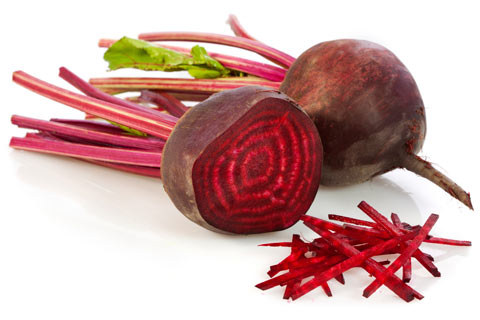Benefits of Beets

Fun Facts:
Brought into Europe by the ancient Romans from North Africa, beets only became a vital commercial crop when Napoleon made them the main source of table sugar to circumvent Britain's lockdown on sugar cane. (i.52)
Beets can make your urine or stool pink or red — a completely harmless, colorful result of natural pigments in beet roots. (i.52)
Though commonly thought of as a root or tuberous vegetable, the tops of beets (Beta vulgaris) are also edible. In fact, they are similar in taste to other members of the same plant family as beets, such as Swiss chard (Beta vulgaris cicla), are eaten as leafy vegetables and do not produce a root bulb. The most common color of beet bulbs is a deep, purplish red, but there are white and gold varieties too. (i.1, 11,52)
As with many red or purple colored vegetables, the bulbs of the most common red beets contain anthocyanins (in particular, betacyanin). These natural betalain pigments that give beets their characteristic deep purple-red color are powerful antioxidants, which help protect tissues from inflammation that destroys connective tissue. These same antioxidants go beyond reducing free radicals to help repair proteins in blood vessel walls. The fiber in beets (both the greens and roots) has also been shown to stimulate production of natural antioxidants and immune system white blood cells in the body, both of which are thought to help protect against colon cancer. (i.2, 52, 53)
Nutritional Content
Beets also contain a number of beneficial nutrients, including: (i.2, 52, 54)
|
|
|
Beet greens are also particularly rich in potassium, which needs to be taken into consideration by people on dialysis who need to limit their potassium intake. (i.55-57)
| BEETS | ||
|---|---|---|
| NUTRIENT | ROOT BULB | GREENS |
| Calories |
37 calories/serving |
39 calories/cup cooked leaves and stems |
| Protein | 1.43 g | 3.70 g |
| Sugars | 6.77 g | 0.86 g |
| Fiber | 1.70 g | 4.18 g |
| Beta carotene | 17.85 mcg | 6609.60 mcg |
| Calcium | 13.60 mg | 164.16 mg |
| Folate | 68.00 mcg | 20.16 mcg |
| Glutamic acid | 0.38 g | 0.45 g |
| Iron | 0.67 mg | 2.74 mg |
| Magnesium | 19.55 mg | 97.92 mg |
| Manganese | 0.28 mg | 0.74 mg |
| Niacin | 0.28 mg | 0.72 mg |
| Potassium | 259.25 mg | 1308.96 mg |
| Selenium | 0.60 mcg | 1.30 mcg |
| Vitamin A | 29.75 IU | 11,021.76 IU |
|
Vitamin B5 |
0.12 mg | 0.47 mg |
| Vitamin C | 3.06 mg | 35.86 mg |
|
Vitamin E |
0.03 mg | 2.61 mg |
| Zinc | .30 mg | 0.72 mg |
Beets have substantial amounts of oxalic acid, which can inhibit calcium absorption. If you consume large quantities of food high in oxalates (e.g., beets, coffee, tea, and potatoes) experts recommend eating foods rich in calcium and supplementing with vitamin D3 to offset this effect. (i.58)
Evidence of Cancer-Fighting Benefits
Beets have long been used in many traditional folk medicines (e.g., Arab, American, German, and Mexican) as a cancer remedy, and modern researchers have uncovered many beneficial effects that may explain its traditional reputation. With an ORAC value 840, beet roots have one of the highest antioxidant potencies in vegetables. Antioxidants help protect cells from free radical damage that can lead to cancer, and lower risk of disease overall. (i.54)
Animal and lab studies show that extracts from beet roots exhibit strong antitumor and antimutagenic activity. Animal studies involving groups of mice (10 in each) with induced skin tumors showed that beet extracts significantly reduced the number of tumors whether applied before or at the same time as the tumor-causing agent. Compared to the untreated control group, the group treated with beet root showed the following: (i.54, 59)
| TREATED GROUP | UNTREATED GROUP | |||
|---|---|---|---|---|
| 5 day pretreatment and then applied 1 hour prior to carcinogen | Applied 1 hour prior to carcinogen | Applied same time as carcinogen |
Carcinogen applied 3 times/week for 20 weeks |
|
| # mice with tumors | 7 | 6 | 7 | 10 |
| # weeks before onset of tumors(average) | 10 | 11 | 9 | 9 |
| # tumors/mouse (average) | 2.9 | 3.0 | 2.1 | 4.7 |
| Average tumor diameter | 1 mm | 1.1 mm | 1.1 mm | 1.6 mm |
These results demonstrate the antitumor effects of beet extracts, and suggest they may offer the same protective benefits in humans. (i.59)
In one clinical study involving patients with stomach cancer, beet juice was shown to potently block the formation of carcinogenic compounds that can form from the nitrates contained in smoked or cured meats. It also inhibited cancerous DNA mutations from these nitrosamines. Beets also help boost the liver's detoxification function in the body. (i.52)
Adding Beets to Your Diet
Containing eight grams of sugar in a 3.5 ounce serving size, beet roots have a sweet, buttery flavor when cooked. In fact, sugar beets (B. vulgaris esculenta) are a source of sucrose — the disaccharide (two sugar) combination of glucose and fructose that forms table, powdered, brown sugar, and molasses. Because they are so sweet, beet roots can also be easily incorporated raw into a salad, pickled, or pressed to extract juice. Beet roots can be roasted, grilled, boiled and sliced, or used as a main ingredient in traditional borscht soup. (i.2, 52, 53, 55)
Beet tops typically taste like a cross between beet root and spinach, and can be eaten in a salad or substituted for spinach or broccoli in cooked dishes. Cook the greens separate from the beet roots by steaming, stir frying, or incorporating into dishes similar to other types of greens. (i.2, 52)
Choosing and Storing Beets
When selecting or picking fresh beets, look for firm bulbs with the leaves attached. To store beet roots and greens, cut off the green tops a couple of inches above the bulb and store separately in the refrigerator — otherwise they will pull moisture from the bulbs. They can last for up to 4 days before using. If you want to freeze beets, cook them first to retain flavor and texture. (i.52)
Preparing to Cook Beet Root Bulbs
Wash the unpeeled roots before cooking. If not organically grown, soak in cold water with some additive free soap and rinse well to get rid of any pesticide residue. (i.52)
Boil or steam beet roots (unpeeled with about an inch of stem attached) until just tender. Wearing kitchen gloves while peeling will prevent the red beet juice from staining your hands when peeling after the beets are done cooking. Adding lemon or vinegar to the water while cooking will turn the beets a brighter red, while baking soda will deepen the purple hue of this colorful root vegetable. (i.52)
Growing Beets
Easy to grow, beets will do best in loose soil that is free of rocks and carries a pH of about 6.5 to 7. Thin and eat seedlings to allow room for the beet root to develop. Plants should be spaced 2 to 4 inches apart for optimal growth. (i.11)



